Life Science - Brain-Function Imaging
Example of Measurement Using functional Near-Infrared Spectroscopy (fNIRS)
How the human brain functions remains one of mankind’s greatest mysteries. Technology for visualizing brain function has advanced rapidly in recent years, but of the various technologies available, fNIRS uniquely allows brain activity to be measured in an environment that most closely approximates natural conditions. Therefore, it has attracted attention as a tool for supporting neuroscience within a wide range of research in healthcare, psychology, education, engineering, and other fields.
Watch the video that shows brain activity being measured while operating a driving simulator.
Principle of Using Near-Infrared Light to Measure Brain Function
- What is near-infrared spectroscopy?
Substances in the body either transmit, absorb, or scatter light. The quantity of light absorbed or scattered varies depending on the wavelength of the light and the molecular components in the biological composition. In particular, hemoglobin in blood absorbs near-infrared light, but that absorption level varies depending on whether oxygen is bound to the hemoglobin. fNIRS is a method of determining the varying quantities of oxygenated and deoxygenated hemoglobin (deoxy-Hb) based on measuring the absorption level of near-infrared light.
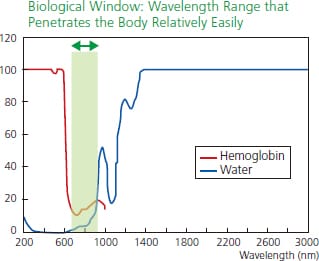
Fig.1 Absorbance of Water and Hemoglobin in the Infrared Wavelength Range
- Why use near-infrared light?
The intensity (spectrum) of light absorbed by oxygenated and deoxygenated hemoglobin is shown on the right. In the visible light range (400 to 700 nm), light absorbance is high for hemoglobin and other biological substances and attenuates to 1/10 the initial value within a penetration distance of 1 mm or less. At longer light wavelengths than near-infrared, high absorption by water prevents almost all penetration into the body. In contrast, the low absorption rate of near-infrared light within the body is much lower, so that it penetrates about ten times farther. Consequently, near-infrared light is used because it can obtain information from deeper locations.
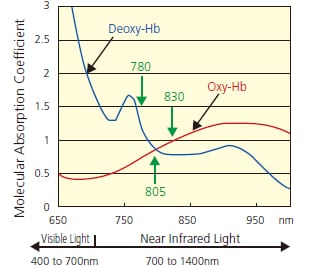
Fig.2 Absorption Spectrum of Hemoglobin
- What can fNIRS tell us?
In the wavelength range measured by fNIRS (700 to nearly 900 nm), the spectrum for oxygenated hemoglobin (oxy-Hb) is very different than the spectrum for deoxygenated hemoglobin (deoxy-Hb). That difference can be used to calculate the varying quantities of oxy-Hb and deoxy-Hb contained in body tissue. Based on those two quantities, the total hemoglobin (total-Hb) can also be calculated and displayed at the same time.
- How hemoglobin quantities are measured?
Optical fibers are used to irradiate tissue with near-infrared light. Each optical fiber is inserted into a special fiber holder worn by the subject, so that the fiber tip is held closely against the scalp. As the incident near-infrared light on the head passes through the cerebral cortex, it is scattered or absorbed, with a portion of the light returning to the scalp. That returning light is detected by receiver optical fibers. The detected light is converted to an electrical signal using a photomultiplier tube and changes in the oxygenated and deoxygenated hemoglobin quantities are calculated based on the modified Lambert-Beer law.
Subject Wearing a Fiber Holder
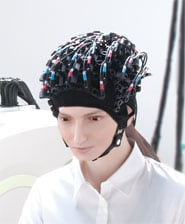
Detecting Near-Infrared Light Reflected from the Cerebral Cortex
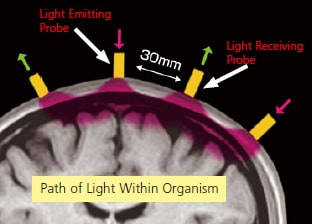
Given a 30-mm distance between incident and detected light, the light reaches depths of about 15 to 20 mm into the cerebral cortex.
- Modified Lambert-Beer law
The modified Lambert-Beer law is a version of the regular Lambert-Beer law modified for the scattering effect of near-infrared light through biological tissue. When incident light passes a distance d through a clear solution, then the logarithm of the output ratio is proportional to d and the absorbance. If the liquid contains scattering substances, then that simple formula cannot be used. In this situation, the actual distance traveled by light through a medium with scattering is longer than d and is expressed as d’. Assuming the value of d’ is unknown, then the modified Lambert-Beer law can be used to calculate the product of the change in initial concentration times the distance the light traveled (d’).
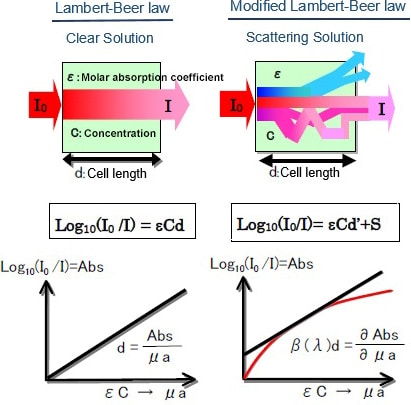
- Illustration of change in oxygenated, deoxygenated, and total hemoglobin concentrations
Near-infrared brain function imaging systems are used to display two-dimensional color maps of brain activity. To measure brain activity, a matrix of optical fibers is arranged (inserted) at the target area of interest. An example of a fiber arrangement is shown below. Assuming variations in oxygenated and deoxygenated hemoglobin levels are measured at an intermediate point between the red (transmitter) and blue (receiver) points, those intermediate points are referred to as measurement channels.
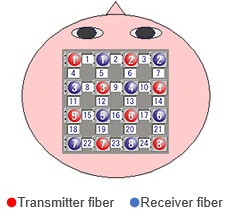
The measured changes in the oxygenated, deoxygenated, and total hemoglobin concentrations are displayed as real-time time-series data for each channel, as shown below. By color-coding and interpolating the data from all channels, the data is displayed on the monitor as a two-dimensional map that shows the distribution in hemoglobin concentration variations. Images can be observed in real time, about 0.1 seconds after measurement.

Related Products
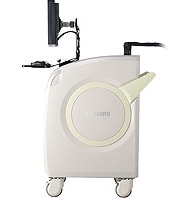
LABNIRS
functional Near-Infrared Spectroscopy System for Research
The laboratory model is ideal for a wide variety of basic research fields.
With a broad range of possible measurement regions, it can be readily customized for specific experimental conditions.

LIGHTNIRS
Portable functional Near-Infrared Spectroscopy System for Research
The portable model is ideal for field research.
It expands the possibilities for measuring brain function in a diverse range of applications and research fields.
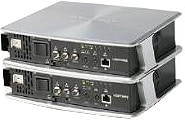
LIGHTNIRS Two-Unit Connecting System
By connecting two LIGHTNIRS units, measurement regions can be expanded to a maximum of 52 channels.


